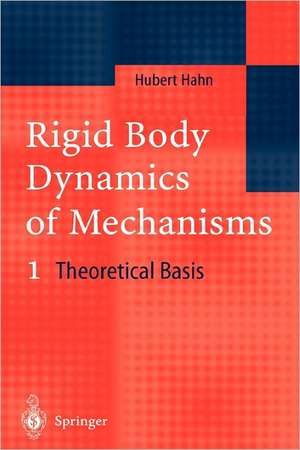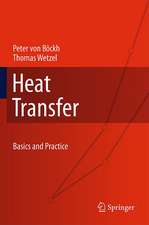Rigid Body Dynamics of Mechanisms: 1 Theoretical Basis
Autor Hubert Hahnen Limba Engleză Paperback – 30 noi 2010
| Toate formatele și edițiile | Preț | Express |
|---|---|---|
| Paperback (1) | 947.35 lei 6-8 săpt. | |
| Springer Berlin, Heidelberg – 30 noi 2010 | 947.35 lei 6-8 săpt. | |
| Hardback (1) | 953.35 lei 6-8 săpt. | |
| Springer Berlin, Heidelberg – mar 2002 | 953.35 lei 6-8 săpt. |
Preț: 947.35 lei
Preț vechi: 1155.30 lei
-18% Nou
Puncte Express: 1421
Preț estimativ în valută:
181.27€ • 189.26$ • 150.03£
181.27€ • 189.26$ • 150.03£
Carte tipărită la comandă
Livrare economică 05-19 aprilie
Preluare comenzi: 021 569.72.76
Specificații
ISBN-13: 9783642076176
ISBN-10: 3642076173
Pagini: 356
Ilustrații: XVII, 336 p.
Dimensiuni: 155 x 235 x 22 mm
Greutate: 0.5 kg
Ediția:Softcover reprint of hardcover 1st ed. 2002
Editura: Springer Berlin, Heidelberg
Colecția Springer
Locul publicării:Berlin, Heidelberg, Germany
ISBN-10: 3642076173
Pagini: 356
Ilustrații: XVII, 336 p.
Dimensiuni: 155 x 235 x 22 mm
Greutate: 0.5 kg
Ediția:Softcover reprint of hardcover 1st ed. 2002
Editura: Springer Berlin, Heidelberg
Colecția Springer
Locul publicării:Berlin, Heidelberg, Germany
Public țintă
ResearchCuprins
1. Introduction.- 2. Planar and spatial vectors, matrices, and vector functions.- 3. Constraint equations and constraint reaction forces of mechanisms.- 4. Dynamics of planar and spatial rigid-body systems.- 5. Model equations of planar and spatial joints.- 6. Constitutive relations of planar and spatial external forces and torques.- A. Appendix.- A.1 Special vector and matrix operations used in mechanics.- A.1.1 Euclidean vector space.- A.1.2 Scalar product and cross product of planar vectors.- A.1.3 Cross product of spatial vectors.- A.1.4 Time derivatives of planar orientation matrices and of planar vectors in different frames.- A.1.5 Time derivatives of spatial orientation matrices and of spatial vectors in different frames.- A.1.6 Derivatives of vector functions.- A.2.1 Kinetic energy of an unconstrained rigid body.- A.2.3 Spatial equations of motion of a constrained rigid body.- A.4 Constraint equations of a general universal joint.- A.4.1 Notation and abbreviations.- A.4.2 Computation of constraint equations.- A.4.2.1 First constraint equation.- A.4.2.2 Second constraint equation.- A.4.2.3 Third constraint equation.- A.4.2.4 Fourth constraint equation.- A.4.3 Computation of the shortest distance between two rotation axes.- References.- List of figures.
Recenzii
From the reviews:
"The present book is a very important and useful introduction of mechanical aspects of mechatronic systems. This book is very useful for undergraduate students of mechanical engineering, control engineering, civil engineering, electrical engineering, mathematics and physics. This book is also very useful for practicing engineers since with this book they have the opportunity of a systematic choice of notation, of an algebraic formulation of all the expressions, of a possibility of direct implementation in a computer and finally of an application … ." (T. E. Simos, Journal of Computational Methods in Sciences and Engineering, Vol. 3 (1), 2003)
"This monograph presents an introduction into basic mechanical aspects of mechatronic systems for students, researchers and engineers from industrial practice. An overview over the theoretical background of rigid body mechanics is given as well as a systematic approach for deriving model equations of general rigid body mechanisms in the form of differential-algebraic equations (DAE). Objective of this book is to prepare the reader for being capable of efficiently handling and applying general purpose rigid body programs to complex mechanics … ." (European Journal of Mechanical and Environmental Engineering, Vol. 47 (2), 2002)
"The present book is a very important and useful introduction of mechanical aspects of mechatronic systems. This book is very useful for undergraduate students of mechanical engineering, control engineering, civil engineering, electrical engineering, mathematics and physics. This book is also very useful for practicing engineers since with this book they have the opportunity of a systematic choice of notation, of an algebraic formulation of all the expressions, of a possibility of direct implementation in a computer and finally of an application … ." (T. E. Simos, Journal of Computational Methods in Sciences and Engineering, Vol. 3 (1), 2003)
"This monograph presents an introduction into basic mechanical aspects of mechatronic systems for students, researchers and engineers from industrial practice. An overview over the theoretical background of rigid body mechanics is given as well as a systematic approach for deriving model equations of general rigid body mechanisms in the form of differential-algebraic equations (DAE). Objective of this book is to prepare the reader for being capable of efficiently handling and applying general purpose rigid body programs to complex mechanics … ." (European Journal of Mechanical and Environmental Engineering, Vol. 47 (2), 2002)
Textul de pe ultima copertă
This monograph presents an introduction into basic mechanical aspects of mechatronic systems for students, researchers and engineers from industrial practice. An overview over the theoretical background of rigid body mechanics is given as well as a systematic approach for deriving and solving model equations of general rigid body mechanisms in the form of differential-algebraic equations (DAE). Objective of this book is to prepare the reader for being capable of efficiently handling and applying general purpose rigid body programs to complex mechanisms. The reader will be able to set up symbolic mathematical models of planar and spatial mechanisms in DAE-form for computer simulations, often required in dynamic analysis and in control design.
Caracteristici
Introduction to the theory of rigid body dynamics Systematic approach for deriving model equations Enables the reader to handle modern general purpose rigid body programs Includes supplementary material: sn.pub/extras












